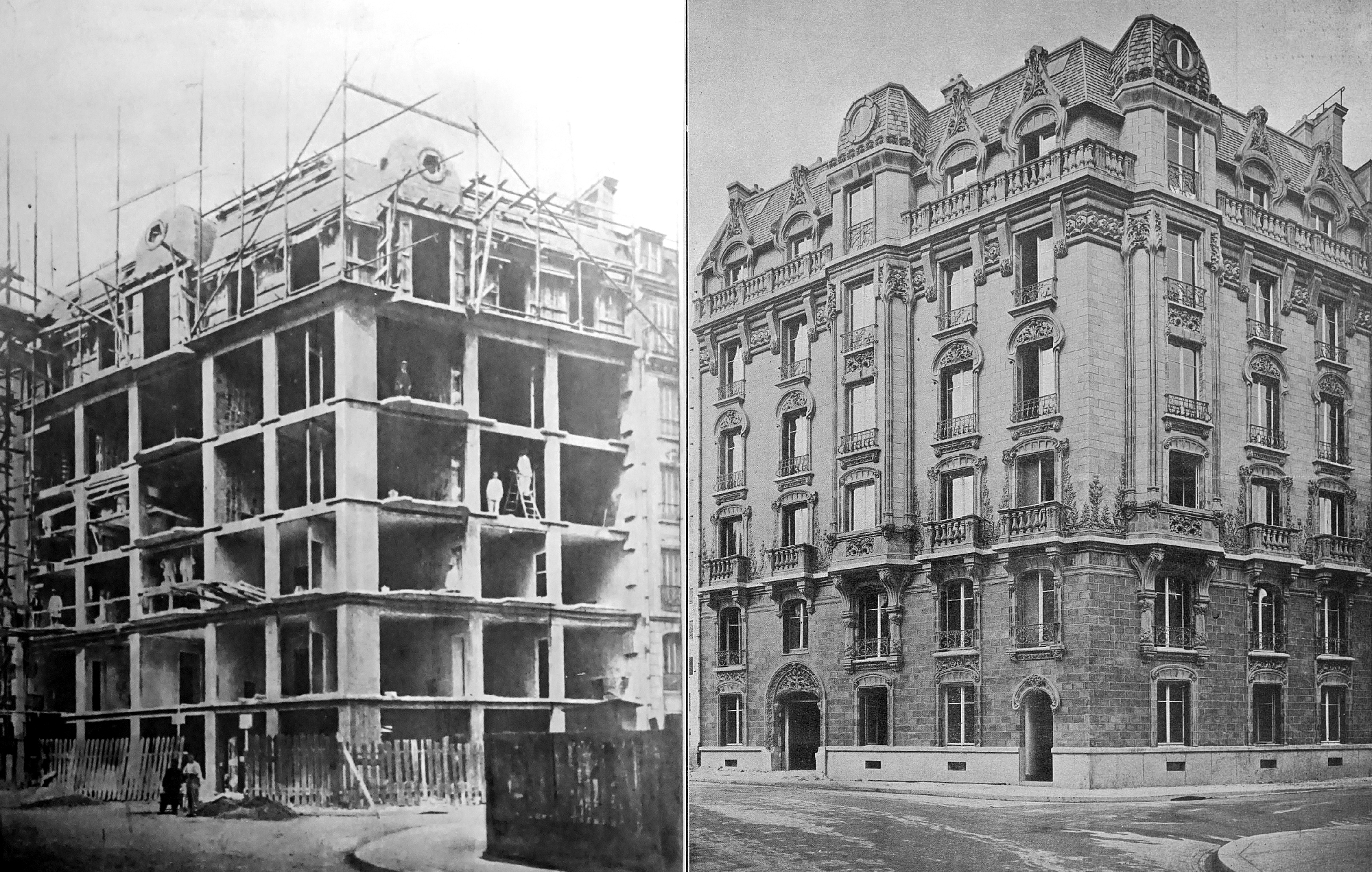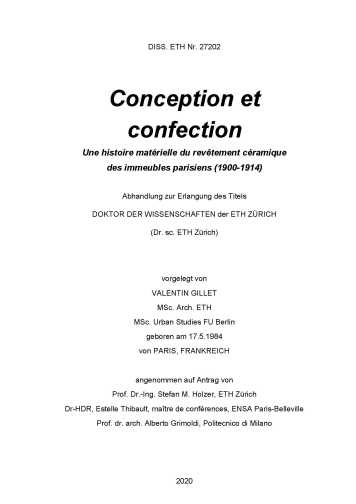V. Gillet: Ceramic Cladding on Parisian Buildings (1900-1914)
Dissertation project by Valentin Gillet on the subject "Conception et Confection: Une histoire matérielle du revêtement céramique des immeubles parisiens (1900-1914)"
Conception et Confection: Une histoire matérielle du revêtement céramique des immeubles parisiens (1900-1914)
Previously only realised in infrastructural projects and industrial buildings, the introduction of reinforced-concrete frames in domestic and commercial architecture during the first years of the twentieth century in Paris required new solutions for the infill and the cladding of such structures. One of the first answers was to infill the concrete skeletons with non-load-bearing brickwork and to clad the building with ceramic tiles. The considerable drop in the prices of such tiles and the evolution of their material properties in these years, especially their resistance to frost, had turned the stoneware tiles in a material of choice for the exterior cladding of buildings, providing a protective shell for the structure within. Stimulated by the editions of the Paris World Fairs of 1889 and especially 1900, the proliferation of treatises and manuals on architectural ceramics and reinforced concrete between 1890 and 1910 illustrates the almost incidental encounter of the two materials, porcelain stoneware and reinforced concrete. The practice of stoneware cladding spread out simultaneously across Central and Western Europe in different ways, establishing the basis of modern architecture for the European metropolis of the twentieth century. The Parisian architects implemented this building technique in a brilliant manner and contributed significantly to the development of the architectural language of Art Nouveau that reached its golden age around 1910. In addition to the concentration of resources and the dynamism of the construction industry, the presence of a strong ceramic industry, which had settled in the city’s northern and western agglomerations during the second half of the nineteenth century and of which the Manufacture Nationale de Sèvres has been the spearhead until this day, sets the case of Paris apart. At the beginning of the 1920s, this building technique was promptly abandoned to make way for other constructive solutions. Commissioned by an enlightened clientele eager to experiment, about thirty objects of this kind, unevenly distributed across the city, were built in the course of this remarkably short period. Despite this rather restraint number of individuals due to the short lifetime of this construction method, this research aims at emphasizing the role endorsed by these buildings in the course of construction history. The objective of the work is to illustrate the constructive solutions implemented by the building industry for the filling and the coating of reinforced concrete frames between 1900 and 1914 in Paris.
- Gillet, V.: Un revêtement céramique sur mesure : L’immeuble L. & C. Hardtmuth, A. Bocage, 1907-1909. In : In Situ, Revue des patrimoines [En ligne], 43/2020, mis en ligne le 14 janvier 2020. external page Online Publikation
- Gillet, V.; Potgeter, W.: Theaterdecken an der Wende vom 19. zum 20. Jahrhundert. Zimmerei und Rabitz im Dachraum des Schauspielhauses Pfauen in Zürich. In: INSITU, Band 12, Heft 2, 2020, S. 269-284. (Research Collection)
- Gillet, V.: Une ponction dans le fonds Paul Guadet: les plans de pose du revêtement de l’Hôtel Carnot, 1906-1908. In: Les Cahiers de la recherche architecturale urbaine et paysagère [En ligne], Matériaux de la recherche, mis en ligne le 22 septembre 2020. external page Online Publikation
- Gillet, V.: An iron-mounted stoneware façade in Paris: Charles Klein’s apartment building at rue Claude-Chahu 9. In: Campbell, J., et al. (Hrsg.): Iron, Steel and Building: Studies in the History of Construction. Proceedings of the 7th Conference of the Construction History Society. Cambridge: Construction History Society, 2020, 129–142. (Research Collection)
- Gillet, V.: La fabrication du grès cérame en France à travers la littérature technique: 1840-1920. In: Aedificare Revue internationale d’histoire de la construction 2/2019, 157–220.
- Die keramische Verkleidung von Eisenbeton – Skelettbauten in Paris. 1900.-1914: Das Wohnhaus 15 av. Perrichont. (4. Jahrestagung der Gesellschaft für Bautechnigeschichte, Hannover, 11.05.2019)
- L’architettura del rivestimento a Parigi: 1900-1914. (Vorlesung im Rahmen des postgradualen Studiums SSBADP (Scuola di specializzazione in Beni Architettonici e del paesaggio) auf Einladung von Direktor Prof. Alberto Grimoldi; Politecnico di Milano, 25.11.2017)
- L’architecture du revêtement céramique à Paris au début du XXe siècle: le 185 rue Belliard. (Vortrag anlässlich einer der Architekturkeramik gewidmeten Tagung "Ces Matières sans rivales" organisiert von der Cité de la Céramique de Sèvres und LabexCAP; Institut national d’histoire de l’art, Paris, 13.10.2017)
- L’architecture du revêtement céramique à Paris: technique et esthétique au début du XXe siècle. (Vortrag im Rahmen der Tagung "Architektur und Technik" Veranstaltet von Robert Carvais (Centre de théorie et d' analyse du droit) und Valérie Nègre (Ecole nationale supérieure d' architecture Paris La Villette); Institut national d’histoire de l’art, Paris, 12.6.2017)

